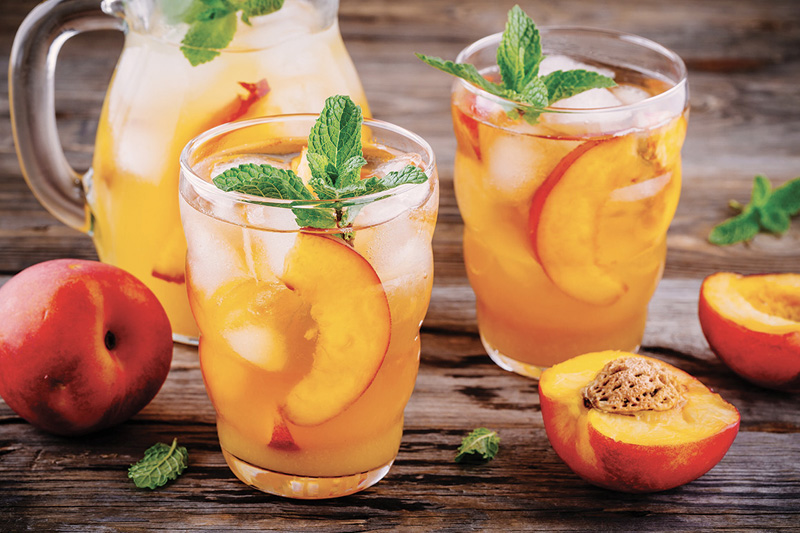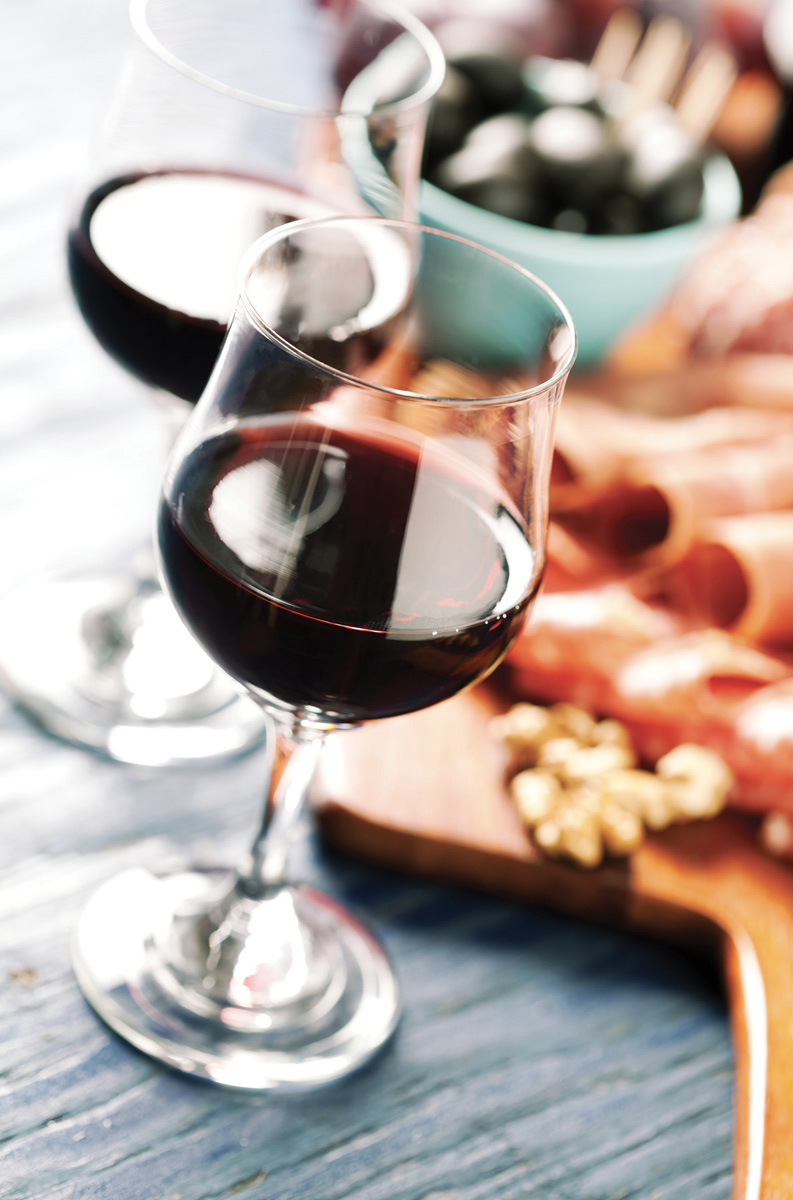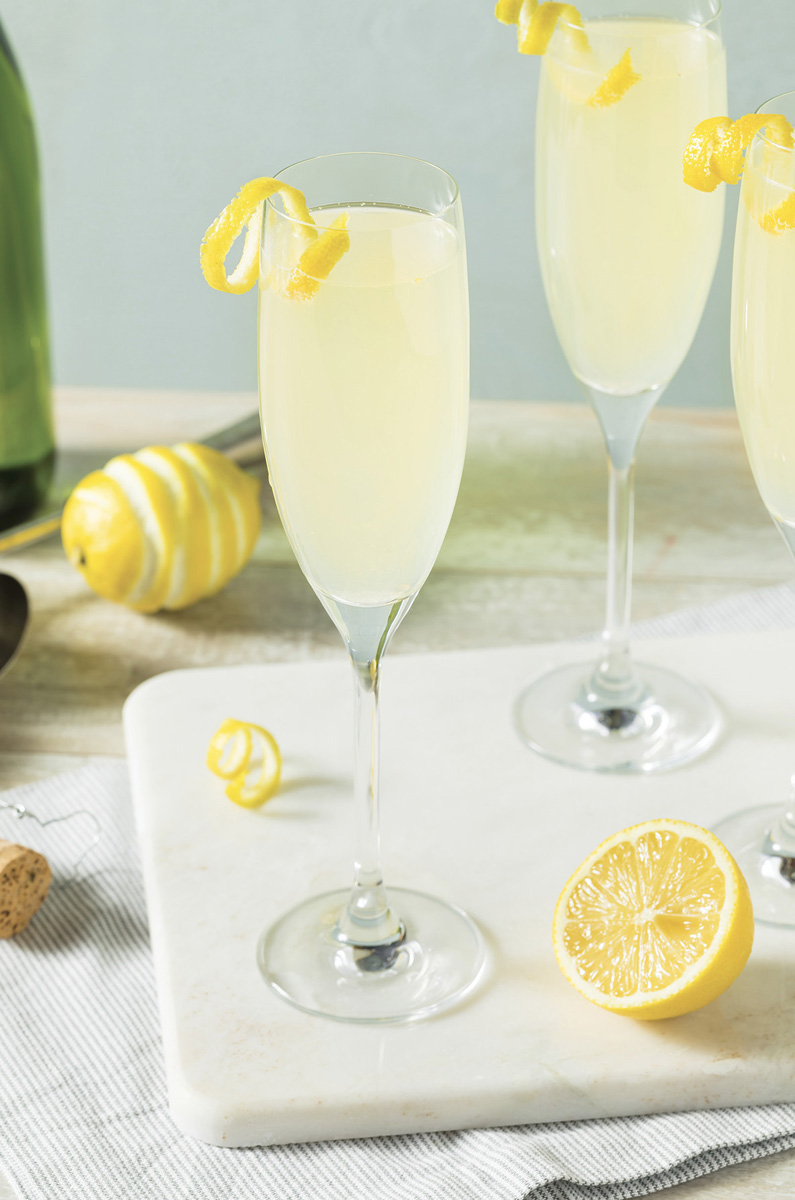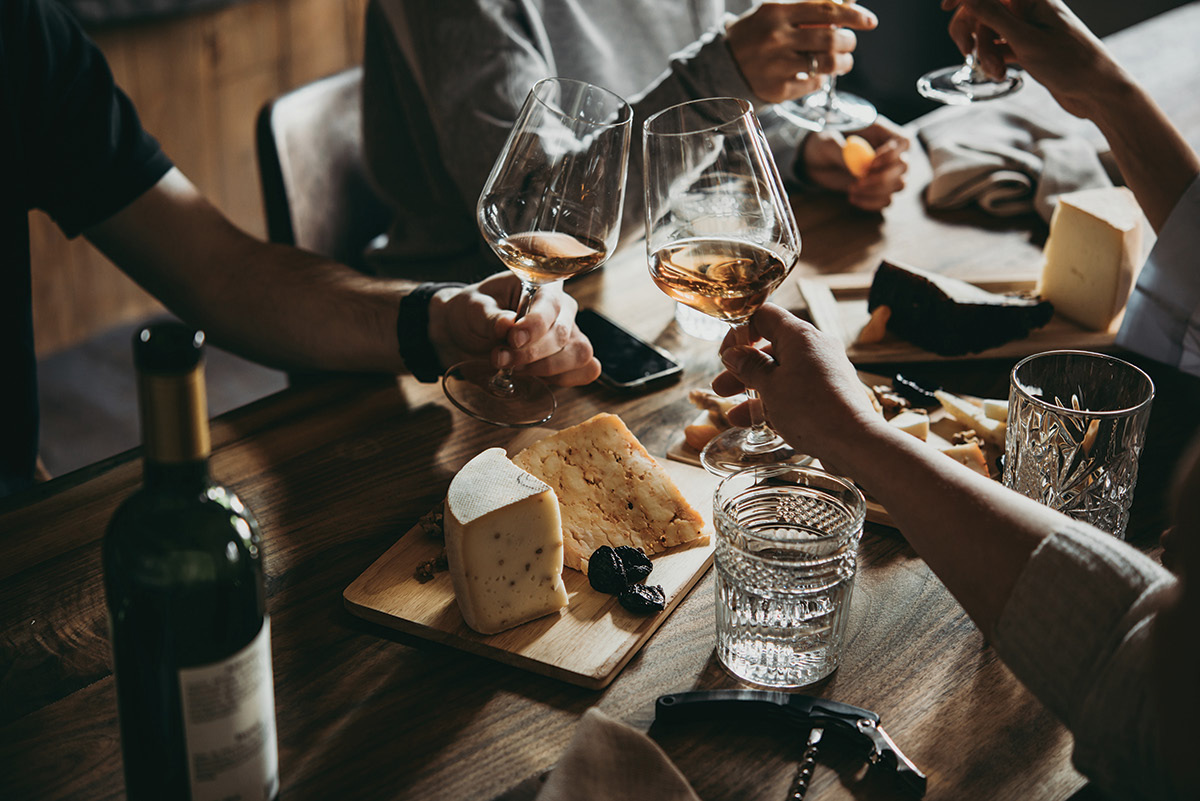Chapter 3
WINE AND OTHER
LIBATIONS
(Vin et Autres Libations)

Recipes featured in this chapter:
French 75
Lemon Rosemary Simple Syrup
Le Voyageur
Cocktail Fraîcheur
In a country whose very name is synonymous with fine wine, the subject has been covered in countless articles and massive tomes. To do the topic justice would require another huge volume dedicated to the delicious fermented juice. Instead, we have compiled a basic framework that you can expand as time and sobriety allow. As a service to our readers, we have been diligent in our efforts to personally lap up as many wines as possible. But we didn’t limit ourselves to wine, because wine is not the only libation the country of France is proud of. Its fabled Cognac, Calvados, Armagnac, and cider are the stuff of legends. They are also essential ingredients in Deborah’s recipes for swanky cocktails.
The Cocktail Hour
One summer, Deborah came to Paris while we were there. She rented an apartment near us. Because outside space is a luxury in Paris, we were amazed to discover that her place had a large, plant-filled terrace with ample seating and tables. This place was screaming for a party.
We popped the bottle of luscious bubbly we’d brought to celebrate her arrival and immediately set about making a guest list. Since Deborah had been in the entertainment business for many years, our list included a distinguished French playwright and one of France’s top TV producers, along with a winemaker from Bordeaux and an Italian actor. We contributed a French architect, a Dutch psychologist who lived in our building, and several expat friends.
Preparing for the party was almost as much fun as the event itself. We loved cooking in the well-appointed kitchen and decorating the place with fragrant bouquets of fresh flowers, which are ever-present in great mounds of color at the farmers’ markets and florist’s shops. The French are devoted to beauty in food, art, nature, and decor, and they have created a cultural atmosphere that allows them to have the time to appreciate it.
Deborah created an exciting charcuterie board with sausage, cheeses, nuts, and rich, creamy pâtés. I was in charge of the fresh figs with bacon, honey, and chili. Although cheese isn’t usually served as an hors d’oeuvre in France, we decided that it was so delicious that we’d present it anyway. I noticed that even the most traditional of our guests snapped it up with compliments for the cook.
It was a lovely night, and the tiny lights Tim had strung around the space gave the terrace a soft glow that made everyone look beautiful. The hum of conversation switched languages effortlessly (of course, Tim, Deborah, and I were madly trying to keep up). We nibbled, drank, and laughed for hours, and it was all so very French and sophisticated that I kept thinking that I must have been cast in a French film.
The following sections detail what Deborah suggests if you want to host your own cocktail party.
Wine (Vin)
Wine. What can we say? So many wines, so little time! France is the place to try as much wine as you can get your hands on. We’ve suggested pairings for many of the recipes, but you can certainly experiment. In America, we are accustomed to shopping for wines based on their varieties, like Cabernet Sauvignon or Chardonnay, but the French identify their wines by the regions in which they were made, not the grape variety. If you look at the back label of a bottle of French wine, you may or may not find a list of the grapes that were used to create the wine.
Here are some suggestions that might help you in your initial foray into the French world of wine. Your very best friend just might be the guy on the corner who owns the wine shop. Usually, these owners are more than happy to talk wine and educate you. Besides, it’s always fun to interact with locals as much as you can. You can also get some brilliant wines at the supermarché. You will probably pay between $14 and $17 for a really nice bottle. The supermarkets make deals with the vineyards so you can enjoy the benefit of their negotiations. In theory, a négociant simply buys, bottles, and sells wine from outside sources. An éleveur “improves” the wine by making it from grapes or freshly crushed juice. Assuming savvy shopping, the result to the consumer can be wine of good value, if for no other reason than that négociant wines are generally more lightly regarded than the estate-bottled and single-vineyard wines made on the premises by producers who grow their own grapes. If you’re willing to trade the cachet (and the price) of estate-bottled wines and don’t insist on top-rank style for everyday drinking, you’ll find that négociant wines—particularly those from companies you’ve learned to trust—can offer a good, characteristic taste of a region and its grapes, without the expense of the more sought-after estate-bottled wines.

Also, be mindful of the year. Good wine from a bad year could be a supermarket ploy! Just like people, vineyards can have good years and bad years. For instance, 2000 was a good year for red Rhônes, while 2001 was not as good. So, if you see a bottle of 2001 red Rhône at an amazingly cheap price, you might want to pass. One of the joys of wine in France is that you can enjoy it in public without being hassled by the constabulary. You can drink it in a city park, along the Seine in the middle of Paris, or out in the countryside. I wouldn’t walk down the street with an open bottle, but if you use common sense, you can imbibe almost anywhere.
In the following section, we’ve listed some of the essential wine regions of France. If you have time, try to explore as many of the appellations and smaller regions as you can. They are less touristy and you will probably get more personal attention at the wineries.
Basic Wine Regions of France
Alsace: This region, which borders Germany, is where a cool, moist climate produces beautiful, lean, dry white wines. Alsace was once a part of Germany, so the food and culture have a Germanic influence. Look for Riesling, Pinot Gris, Gewürztraminer, and Sylvaner. This is the one area of France where the wines are usually named after their grape variety instead of their place of origin. Alsatian dry and off-dry white wines generally pair well with creamy sauces, scallops, tartiflette, foie gras, lobster, roast turkey or goose, and charcuterie as well as French Munster cheese and many washed rind cheeses.
Bordeaux: This region is one of the largest and oldest wine-producing regions of France. It is where you will find wines made from the five great grapes: Cabernet, Merlot, Cabernet Franc, Petit Verdot, and Malbec. You can find bargains here, especially in the outlying appellations (there are 57 appellations in Bordeaux). You can also find some of the most exclusive and expensive wines in the world. You’ll enjoy these wines with game or aged beef. Open the wine at least 30 minutes before you’re ready to drink it so that it can develop fully.
Bourgogne (Burgundy): This region is home to many costly and sought-after wines because this is where the famous French Pinot Noirs are made. The moderate climate is what fussy Pinot Noir vines crave. Chardonnay is the other grape this area is known for, but this isn’t your grandma’s Chardonnay. These are made with such finesse and balance that you may not recognize them as such. French Pinots are terrific with salmon, duck and other game birds, mushrooms, roast pork, and also with many types of cheese.
Champagne: Not all sparkling wines from France are called Champagne. Only sparkling wines from the Champagne region of France can be called Champagne. Period. No exceptions. And they are worth it. Champagne is available everywhere, and in France it won’t break your budget. So indulge yourself and enjoy feeling très chic! In this book, all references to champagne (lowercase) will refer to sparkling wines that are not made in the region of Champagne.
Languedoc-Roussillon: This region tends to be dry, allowing for a longer growing season. Full-bodied wines are the result. These tend to be good finds when you are searching the aisles in the wine shop. They lean toward spicy, which means wines from this region pair well with rustic dishes, wild game, and sausages. We love a full-bodied Corbières. This is also the home of Banyuls, which Wine Enthusiast Magazine called the ultimate dessert wine.
Loire: This exquisite region features rolling hills speckled with châteaux. Sauvignon Blanc is grown here to make one of our favorite wines, Sancerre. Vouvray, made from Chenin Blanc, is also a favorite. You can find a lighter version of Cabernet Franc here, as well as Pinot Noir, which is not as pricey as those found in the Bourgogne region. The Muscadet here is delicious. You’ll notice that the wines tend to be lighter due to the cooler climate. Saumur-Champigny region wines are medium-bodied. Not only is this wine very easy to drink, but it’s also surprisingly affordable. You can enjoy it paired with almost anything, such as chicken or vegetarian meals. And it’s phenomenal with goat cheese, which makes sense because chèvre is so plentiful in the Loire Valley that you can find it in vending machines!
Provence: This is the oldest wine-producing region in France. If you are a dry rosé fan, look for rosés from this part of France. You will be delighted. This traditional rosé is not at all sweet. Treat yourself to a Bandol, if you can find one. Drink with shellfish, goat cheese, pâté, roasted beets, charcuterie, sheep milk cheeses, and mushroom tart or quiche.
Rhône: This region is home to 22 grape varieties. The most commonly known red varieties are Syrah and Grenache, and Viognier is perhaps the best known white variety. The sun-drenched hills produce somewhat fruitier and more condensed flavors with a bit of spice. Look for Côtes du Rhône, Côte Rôtie, and the pricier Châteauneuf-du-Pape, which can be a blend of as many as 14 grape varieties as well as beautiful rosés. Generally, Rhône reds match extremely well with braised lamb, grilled meats, wild game, sausages, stews, and roasts.
Spirits (Spiritueux)
Naturally, most people think of wine as France’s most significant contribution to the culinary world, but the French have also been making spirits for hundreds of years. The following are the ones you should sample as you graze and drink your way through the country.
Absinthe: This spirit has a colorful history. It is nicknamed the Green Fairy because it was thought to cause hallucinations and alcoholism. This maceration of fennel, wormwood, and anise was invented in Switzerland. The anise gives absinthe a licorice flavor, and wormwood accounts for its green color. It finally gained acceptance again in 2007, and it is used in absinthe-based cocktails like the absinthe frappé or the Sazerac.
Armagnac: This heavier, more flavorful spirit is distilled only once from the same varieties of grapes as Cognac. The region of Armagnac is a much smaller area than Cognac, so it’s easy to find smaller producers.
Bénédictine: Also an herbal liqueur, Bénédictine was created by Alexandre le Grand. Any monastic connections are fabrications! It’s usually consumed neat, and its rich, peppery, honey-sweet flavor is memorable. The best-known classic Bénédictine drink is the Singapore sling.
Calvados: This is an appellation-controlled apple brandy from the Normandy region in northwest France. It’s wonderful in applejack-based cocktails, but it’s best served as a between-course refresher known as a trou Normand.
Chambord: Made from raspberries and gorgeous in bubbly or with vodka.
Chartreuse: Carthusian monks began making Chartreuse in 1737 (using instructions that dated from 1605). It contains 130 different herbs, spices, roots, and barks, and comes in two varieties: green Chartreuse, which is spicy and dry, and yellow Chartreuse, which is softer and sweeter.
Cider: Brittany and Normandy may not have the best climate for growing grapes, but they have the ideal apple-growing climate. Hence these areas produce some of the finest cider you will ever have. Best served cold.
Cointreau: Although this also has a bitter orange taste, its base is a neutral spirit in comparison with Cognac. Its cleaner, light properties make it perfect for cocktails such as sidecars, cosmopolitans, and margaritas.
Cognac: The manufacture of this brandy is regulated by the AOC (Appellation d’Origine Contrôlée, or “protected designation of origin”), so only brandies from the Cognac region of France can be called a Cognac. There are strict rules that demand that Cognac be made in copper pot stills and aged in French oak (for a minimum of two years). When you buy genuine Cognac, try to find smaller producers who have control over the entire process.
Crème de Cassis: Made from blackcurrants and best served at room temperature after dinner or in a cocktail.
Eau-de-Vie: Colorless brandy.
Grand Marnier: This sensational bitter orange liqueur was created in 1880 by Alexandre Marnier-Lapostolle. The liqueur is a required ingredient in the famed Cadillac margarita, but it can also be sipped straight after dinner.
Guignolet: Liquor made from cherries and best served chilled as an aperitif.
Pastis: Anise-flavored aperitif and best served cold with water or ice cubes.
Pernod: Anise-flavored and best served with water and ice.
Beer (Bière)
Although France has not been known for its beer in the past, the microbrewery craze that has taken America by storm has now invaded France. And that’s a good thing. Even though you could certainly find beautiful beers from all over the world, French beers, in our opinion, were nothing to write home about, except near the Belgian border where hops grow best. But every year it is becoming easier to find good craft French beer, the best being from the north of France, the beer-drinking region par excellence. Beer that you buy in the shops will be slightly less expensive than what you’ll find in restaurants.
And let’s not forget about cider! There are lots of good artisanal ciders in better crêperies, and they are just beginning to pop up on menus in nice cafés. The French observe their rules and to them, cider goes with crêpes and perhaps food from Brittany, but never with quiche Lorraine or coq au vin.
 COCKTAILS (Cocktails)
COCKTAILS (Cocktails)
AFTER A MEMORABLE DAY rejoicing in the wonders of France, what could be better than settling down on your balcony or terrace or sitting comfortably under a tree to enjoy a sensational French cocktail?
French 75
 serves 2
serves 2 
One of our favorite cocktails. But be careful because they go down very easily!
Ingredients
1 lemon
3 ounces (90 ml) gin
3 ounces (90 ml) Lemon Rosemary Simple Syrup (optional; see page 67)
½ cup (125 ml) champagne
Equipment
2 tall glasses
Measuring cups and spoons
Zester or paring knife
Method
1. Slice the peel from the lemon with a zester in a long spiral. Cut in half. Juice the lemon.
2. Mix together gin, 2 tablespoons (30 ml) of the lemon juice, simple syrup (if using), and champagne. Pour into two glasses with ice. Garnish with curled lemon peel.
3. Try to drink it slowly. Or not.
Lemon Rosemary Simple Syrup
 makes about 1½ cups (350 ml)
makes about 1½ cups (350 ml) 
Simple syrup is called so because it really is the easiest thing to make, other than toast.
Ingredients
1 cup sugar (200 g)
1 cup water (240 ml)
Half of a lemon
1 small sprig of rosemary
Equipment
Measuring cup
Small pot
Spoon for stirring
Method
1. Add the sugar then the water into a small saucepot. Squeeze the juice from the lemon half into the pot and then toss the depleted half into the pot as well. Add 1 small sprig fresh rosemary.
2. Bring to a simmer, then let cool.
3. Fish out the rosemary and lemon, squeezing the moisture back into the pot.
4. Save in a jar or a small bowl to use in your cocktails or to drizzle over pound cake.
Variations, Ideas, Suggestions
• Use your imagination when making other kinds of simple syrup. Our friend Camille makes some with tea leaves. Other options can include thyme, black pepper, coriander, rose petals, lavender, mint, lemongrass, ginger, basil, grapefruit rind, and . . . the possibilities are endless.
• Drizzle it over cake or ice cream. Sweeten your tea, lemonade, or even your coffee with it. Add it to Chantilly cream. Or invent a fun new cocktail!

Le Voyageur
 serves 1
serves 1 
This lemony, earthy concoction will have you begging for another.
Ingredients
2 juniper berries, crushed under the flat side of a knife
1 small lemon wedge
1 sage leaf
2 ounces (60 ml) gin
1 ounce (30 ml) Lillet
1 teaspoon (5 ml) brandy
2 ounces (60 ml) tonic or soda
Equipment
1 short glass
Measuring cups and spoons
Wooden spoon or muddler
Method
1. In a short glass, muddle the juniper, lemon, and sage leaf with a wooden spoon.
2. Add ice and the gin, Lillet, brandy, and tonic.
3. Stir and enjoy.
Cocktail Fraîcheur
 serves 6
serves 6 
This citrusy delight will brighten spirits anytime.
Ingredients
¼ cucumber, cut into ⅛-inch (3 mm) slices
1 lemon, cut into ⅛-inch (3 mm) slices
½ orange, cut into ⅛-inch (3 mm) slices
1 lime, cut into ⅛-inch (3 mm) slices
10 mint leaves
8 ounces (240 ml) bourbon, vodka, or gin
1 tablespoon (15 ml) honey or Lemon-Rosemary Simple Syrup (see recipe page 67)
Soda water to taste
Equipment
Knife for slicing
Measuring cups and spoons
Wooden spoon or muddler
Method
1. In a large pitcher, combine everything but the soda water. Lightly muddle with a wooden spoon. Add ice.
2. Add soda water, one cup at a time, until it has the flavor you want. We tend to like about half soda water and half everything else.
WINE FESTIVALS




